The Commons Education Select Committee met yesterday. One of their current inquiries focuses on tackling persistent absence. At the meeting, Dame Rachel De Souza, England’s children’s commissioner, spoke of her concerns about children missing lots of school on Fridays. The data she analysed was from Autumn 2021, so we thought we’d share an updated picture, using Autumn 2022 data from our 10,000 Attendance Tracker schools.
Absence by day of the week
First, let’s look at the percentage of sessions missed by day of the week and time of day for all pupils.


At both primary and secondary, there tended to be more absence on Friday than any other day. And absence tended to be lowest on Wednesdays. The difference was larger for secondary than primary. At secondary, absence on Friday afternoons was 1.8 percentage points (pp) higher than Wednesday mornings, the period with the lowest absence. At primary, the difference was 1.4pp (between Friday afternoons and Wednesday afternoons).
But what does the picture look like for pupils who miss lots of school? Let’s plot the same charts, but this time just include pupils with absence rates of 50% or more (“severe absentees” – note the y-axis doesn’t start at zero).
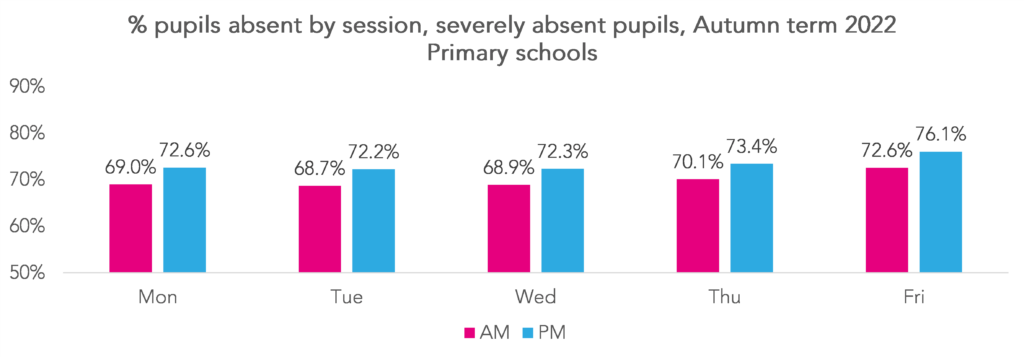
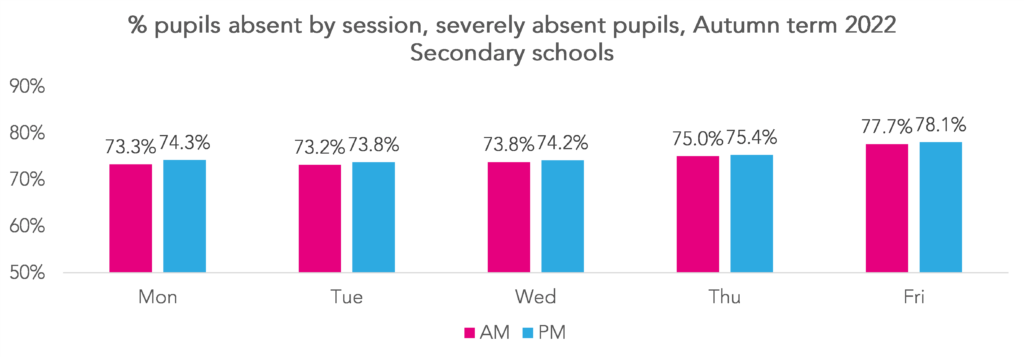
Again, we see that absence tended to be highest on Friday afternoons. But the difference between Friday afternoons and the period with the lowest absence (7.3pp at primary and 4.9pp at secondary) was larger for severe absentees than for the general population.
Reasons for absence
To investigate what could be driving this, we compare the reasons for absence recorded on Fridays with those used on Wednesdays. We’ll do this for all pupils, then just for those who were severely absent. First, all pupils:

The two main drivers of higher absence on Fridays than Wednesdays were higher rates of illness and of unauthorised absence. The difference for illness related absence (0.8pp higher on Fridays than Wednesdays) was slightly higher than unauthorised absence (0.6pp higher).
Looking at the same data for severe absentees:
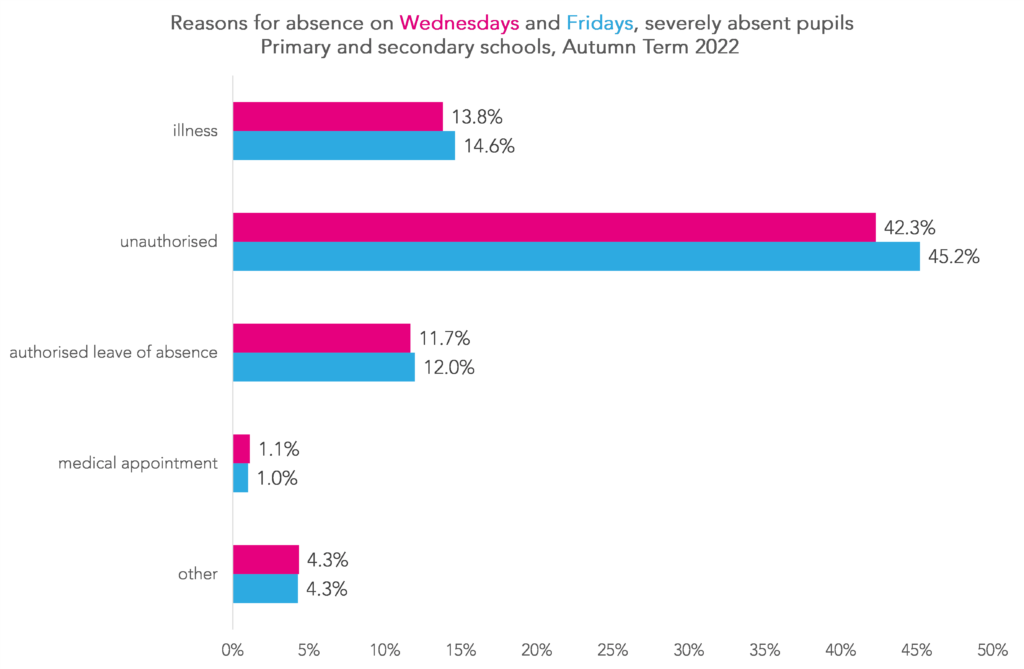
The difference between illness-related absence on Fridays and Wednesdays was similar to the general population – around 0.8pp. But the difference in unauthorised absence was larger at 3.2pp.
Repeated absence by day of the week
We change tack slightly now and look at pupils who were repeatedly absent on different days of the week.
Below we show the percentage of secondary school pupils who missed at least 50% of Monday mornings, of Monday afternoons etc. And we split the data by disadvantage.

Overall, 1.5% of pupils missed at least 50% of sessions every day of the week. Apart from Fridays, around 3% of pupils missed at least half of sessions on any given day. On Fridays, this increased to around 3.5% of pupils.
For disadvantaged pupils, the difference was more marked. Between 6% and 6.5% of pupils missed at least half of Monday to Thursday sessions, compared with around 8% of Fridays.
We can also look at this by pupils’ special educational needs (SEN) status.

Of those with education, health and care plans (EHCPs), between 9.5% and 10.5% of pupils missed at least half of Monday to Thursday sessions. This was only slightly higher for Friday mornings (10.8%), and highest on Friday afternoons (11.5%).
Aspire Attendance Tracker
Schools can track, analyse and compare their attendance data against 1,000s of other FFT schools using Aspire Attendance Tracker.
Log in to Aspire to access Attendance Tracker – log in here.
Not an FFT Aspire user? Learn more here.
Summing up
We’ve seen that the situation Dame Rachel described for Autumn 2021, where pupils missed more school on Fridays than other days, continued in Autumn 2022. And we’ve seen that this appears to be more widespread among severe absentees than the general population, and among pupils who are disadvantaged and/or have an identified SEN.
She went on to suggest that the reason for pupils missing more school on Fridays than other days was that their parents were more likely to be at home on Fridays. As we’re limited to what’s recorded in the register, we can’t test this.
She also suggested that this pattern wasn’t there before the pandemic. Unfortunately, we can’t test this either because we only started collecting daily attendance data after the pandemic started.

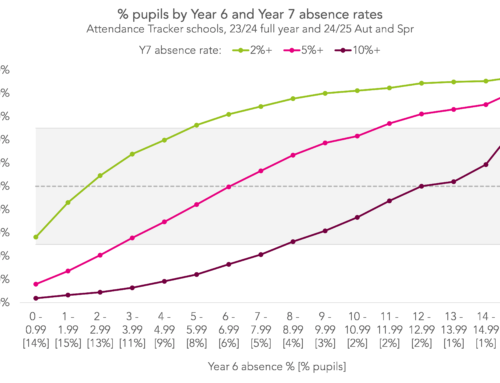

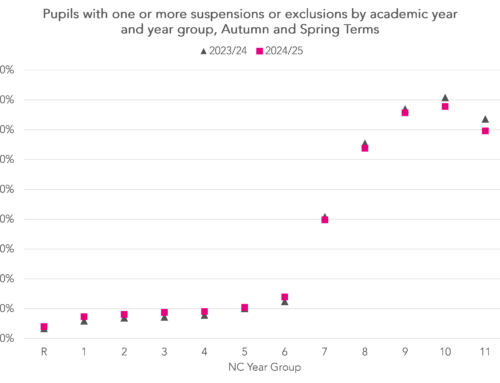

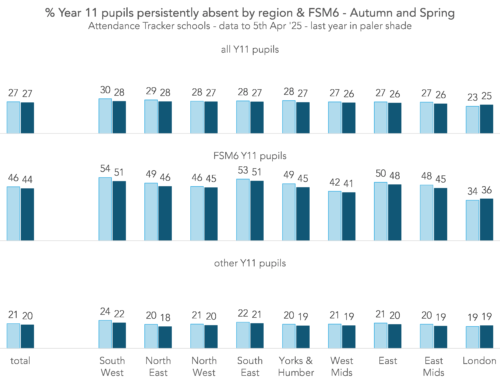
Comments from the Children’s Commissioner seem to be indicating that schools do more to make it more attractive for pupils to attend on Fridays. Where has parental responsibility disappeared to? As a former teacher with responsibility for attendance monitoring it always dismayed me that parents wantonly absented their children on Fridays because it suited their own arrangements. Ringing parents often unearthed the real reason but this was covered over with an absence note that indicated illness etc. This would then be the “official “ reason appearing in any statistical return.
This indicates a parental devaluation of education and a need for their re-education rather than pushing schools into more add-ons that already overwhelmed staff would have to provide.
An illustration of this devaluation happened this morning. I am writing on March 10th, a day of nationwide heavy snow. Only a handful of my local schools deemed it necessary to close. As I was out walking I met my neighbour and her daughter who I thought were walking to the nearby school which was open. As I chatted to them the mother revealed that she wasn’t sending her child to school today because she wanted her to enjoy the snow and promptly walked past the school with sledge in hand towards the local slopes!! As this was a neighbour and friend of my own daughter I was banned from explaining what the child was missing and the social contract that the parent has with a school!
Mondays and Fridays have always been high for absences due to parents going away for “long weekends” even pre COVID.